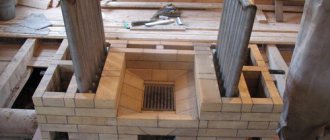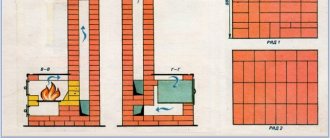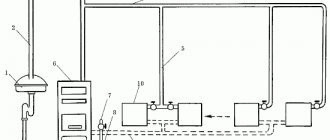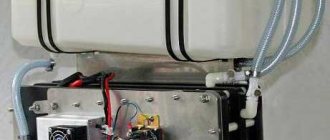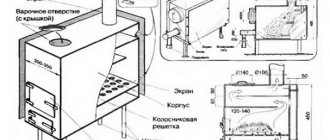Efficient home heating is one of the most important tasks for every homeowner. An interesting solution to this problem could be a steam heating system, the operating principles and design of which differ from the usual water circuits.
This is not the easiest option, and has its own strengths and weaknesses. We will talk about the rules of design and organization, the features of the system with a vapor coolant. You will learn how to install steam heating in a private home and how to operate it correctly.
Features of low pressure systems
A common version of such a system is closed, using gravity return of condensate to the boiler, which does not completely fill the pipes, and an upper pipe distribution is used.
First, the system is filled with water to the required level, after which heating begins. The condensate flows down a common riser and, when a predetermined level is reached, is forced into the boiler.
In the same system with bottom distribution, it is recommended to install pipes with a slight slope in the direction of steam movement in order to reduce noise effects. At the point where the condensate is drained, a loop-shaped water seal is installed, which prevents the movement of steam onto the condensation line.
The steam velocity in such systems should be moderate, no more than 0.14 m/s. Otherwise, the steam will also capture particles of moisture accumulated on the walls. As a result, the system operates with more noise and increases the risk of water hammer.
Combined wiring, i.e. a combination of upper and lower wiring is used if pipes are laid under the floor of the upper or middle floor of the house. The lumen of the pipes through which water returns to the boiler will in this case be closed by condensate.
If the pressure in the system exceeds 0.02 MPa, it should be made open. The air is removed through a condensate storage tank, and to prevent steam from leaving the system, a condensate drain or water seal is installed. Water from the storage tank is pumped into the heat exchanger, which allows the storage tank to be installed below the level at which the heat exchanger is located.
The coolant for heating a private house with a boiler room is heated in a heat exchanger located in the boiler room. Upon reaching the operating temperature, the steam moves to a manifold that divides the flow into two circuits: for the main rooms and for the boiler room (+)
Wood-burning brick oven
If stove heating is used to heat the home, then the main question that needs to be resolved is where to install the heat exchanger or steam generator. There are several options. The generator can be a coil or a boiler.
To ensure that the water in the generator heats up quickly, it can be installed directly into the firebox. The water will boil quickly, but the equipment will soon become unusable. It will be under constant exposure to fire.
The coil is built into the brick walls of the furnace, filled with mortar. This design will last a long time. The water will absorb the heat that is transferred through the brick walls. It will boil quickly. This design option has some disadvantages. If a breakdown occurs in the coil, it will be impossible to eliminate it. You will have to disassemble the furnace wall and install a new heat exchanger.
It is suggested not to embed the generator into the walls. A separate niche or several niches are built for the tank or coil. They are laid out of brick from the sides or from the far wall: you need to decide where it is more convenient to install the pipes. The niches are connected to the combustion chamber of the stove with dampers. If necessary, the dampers are opened. The coil begins to heat up and release water or steam into the main line.
It is not recommended to install the steam generator close to the wall. Soot and dirt can get into the niche. It should be possible to clean the surface of the coil and the niche itself. The steam line can be connected to the boiler or directly discharge steam to radiators or to the “warm floor” system.
We recommend: How does steam electric heating work?
The system must be equipped with control devices to regulate the temperature and steam pressure. The optimal outlet temperature is 150 0C. The pressure at the outlet to the steam line is 170 kg/m2. When installing the main line, it is not recommended to use fittings. The pipes are connected by welding seams.
Assessing advantages and disadvantages
What are the benefits of a steam heating system? It is relatively easy to make even on the basis of a conventional wood stove. This is especially true in areas where there is no centralized gas supply, but firewood or other solid fuel is quite accessible.
Steam is significantly ahead of water as a coolant. Its heating rate is three times higher. In addition, a steam heating system is unlikely to fail during winter cold due to lack of heating.
If the firebox burns out, water from the system will collect in the storage tank or heat exchanger, and the pipes and radiators will remain empty. With water heating, freezing of the coolant, which fills the entire circuit, is known to lead to pipe rupture.
Finally, the dimensions of steam heating radiators should be significantly smaller than for water systems, since the amount of thermal energy obtained as a result increases several times. This will slightly reduce the cost of installing a heating system at home.
Decorative grilles for steam heating radiators are not only an element of interior design, but also a means of protection against burns
This concludes the list of advantages of the steam system, and we can move on to its disadvantages, which are quite significant:
- high risk of burns;
- increased noise level during operation;
- difficulties in adjusting the operation of the system;
- the need to purchase expensive pipes, etc.
Safety standards do not recommend steam heating for residential premises, as it poses a high risk to the health and life of people living in the house.
Thus, the operating temperature of the radiators will be very high, and if you touch them you can get a serious burn. Therefore, all radiators will have to be covered with reliable decorative grilles.
Ordinary PVC pipes are not suitable for such a system, since they must withstand high pressure and temperatures of more than 100 degrees. The same requirements apply to other elements of the system. Steam heating pipes must be copper or galvanized steel.
Copper pipes are an ideal, but not at all cheap, communication option for steam heating systems. To connect these pipes you will need a welding machine
In any case, this moment cannot be called budgetary. Security issues must be given the utmost attention. All installation work, for example, welding copper pipes, will require the highest quality performance. If the connection ruptures and a stream of steam escapes through the hole, one of the occupants of the house risks serious burns.
Stainless steel pipes are able to withstand the loads typical of steam heating systems, such as high temperature and increased pressure in the system
Another disadvantage of steam heating is the increased noise level. To fix this problem, you must install the radiators correctly. They are suspended on special anti-noise brackets. It is best to place the boiler or stove in a separate room. In addition, copper pipes can be placed in the thickness of the walls, which will also reduce the noise level.
Finally, it is a little difficult to regulate the heating temperature in rooms with steam heating. You cannot install a thermostat and simply reduce the amount of steam. You will have to reduce the amount of fuel, which is not always easy, or ventilate the premises. Before starting work on installing a steam heating system, all these points should be taken into account.
The difference between steam heating and water heating
The principle of operation of a steam heating system is as follows: water brought to a boil in a container turns into steam, which then enters the heating radiators, heating them. There, the steam condenses, transforming into a liquid state, flows into the expansion tank through special outlets, and then returns to the heat exchanger.
The difference between steam heating and water heating is, firstly, the circulation of different types of coolant. Secondly, heat transfer is higher, and the rate of warming up the room is several times faster than that of water. With the same costs for solid fuel, the efficiency of steam heating is higher than water heating.
Installation of steam heating does not require large equipment, which makes this heating system economical. If the system is inactive, pipes with coolant water may freeze over the winter. In contrast, a steam system can be easily started without experiencing such difficulties.
There are also some disadvantages that a heating system with water coolant does not have:
- Heating radiators heat up over 100 degrees, which can be unsafe for others.
- Heating system is very noisy
- Difficult to regulate temperature
- Inability to install a water heated floor system.
- Plastic pipes cannot be used for the system.
- An oven with a built-in steam heating system is difficult to use for cooking at the same time.
Design of a steam heating system
Even for a small room, it is best to draw up a project. A system made at random will most likely soon require rework, and a diagram drawn up on paper will allow you to immediately identify weak points and correct them.
For example, in order to create a system with natural coolant circulation, the heat exchanger, and accordingly the heating device, should be located at the lowest point of the house.
The steam and condensate pipelines of heating systems with a natural type of coolant movement are arranged with a slope in the direction of its movement (+)
This means that the stove or boiler must be located below all radiators, as well as pipes that are not vertical, but horizontal or at an angle to the vertical.
If it is not possible to place the heating device in this way (the house does not have a basement, the basement is used for other purposes, etc.), preference should be given to heating with forced circulation.
The diagram shows a heating system with forced circulation. To install it you will need a circulation pump and a storage tank.
Therefore, it is necessary to include a pump in the steam heating circuit that will pump water into the heat exchanger. An important point in designing a heating system is the order in which the radiators are connected. A sequential connection or the so-called one-pipe system involves connecting all radiators in order.
As a result, the coolant will sequentially move through the system, gradually cooling down. This is an economical connection option, which is easier to install and will be cheaper.
But the uniformity of heating with this method will suffer, since the first radiator will be the hottest, and the last coolant will enter in a half-cooled state.
Single-pipe connection of radiators, as can be seen from this diagram, involves sequential installation. The coolant reaches the last radiator already cooled down
A single-pipe solution may only be acceptable when connecting steam heating in a country house or in a small house with an area of less than 80 square meters. m. And for a spacious cottage or two-story building, a two-pipe system in which radiators are connected in parallel is more suitable.
The single-pipe design ensures simultaneous rather than sequential flow of coolant into each radiator, and the rooms are heated more evenly. But with a two-pipe circuit, two pipes will have to be connected to each radiator: direct and return.
Such a system is more difficult to implement, and it will cost a little more than when installing a single-pipe system. However, the vast majority of water heating systems are made according to a two-pipe scheme, despite the difficulties, and function quite successfully.
This diagram shows a two-pipe installation system for steam heating radiators. Each radiator is connected to a common riser and has a return pipe, which ensures uniform distribution of coolant
If you plan to use a wood stove as a heat source, you should immediately calculate and design a special heat exchanger. It looks like a coil welded from metal pipes. This element is built directly into the furnace structure, and is not installed separately.
Therefore, the design of a new furnace should also be considered at the design stage. You can also use an existing stove, but it will have to be partially disassembled in order to install the heat exchanger inside.
To obtain 9 kW of heat, a heat exchanger with a surface area of about one square meter is required. The larger the heated area, the larger the size of the heat exchanger should be.
If you plan to heat the room using a boiler, then everything is a little simpler: you need to buy and install it. Usually, for steam heating in a house, it is recommended to take a water-tube boiler model, as it is the most efficient.
Although fire-tube, smoke-combustion or combined smoke-fire-tube models can also be a completely acceptable option.
Sometimes, to organize steam heating, they use a homemade boiler in which waste engine oil is burned. But this option is considered suitable for use in utility rooms, for example, in a garage. For a residential building, this option is not very good.
Furnace heat supply methods
Construction of a stove with a heating circuit
Having understood how heating can be done from a stove, you should choose the right method for heating the room. To do this, you can use standard heat supply schemes, which will have a brick structure instead of a boiler.
The main selection criterion is the total area of the house. The required maximum cooling rate of the coolant as it passes along transport routes depends on it. Depending on this parameter, you can choose the following types of heating a private house from a stove:
- Vodyanoye . The most popular and simple, but also labor-intensive;
- Steam . Most often used for houses with large areas and high-temperature furnaces;
- Air is the best option for a country house.
Each of the systems has a number of characteristic features of arrangement and operation.
Water stove heating
Optimal water heat exchanger for a stove
The most important component of water heating from a stove made independently is the heat exchanger. It is designed to transfer thermal energy from the combustion of fuel (wood, coal) to water in the system. It is best to make it yourself, since each stove often has individual dimensions of the combustion chamber. For this, it is recommended to use heat-resistant steel with a thickness of at least 2 mm. The design of a stove for a summer cottage with water heating can be different. The main condition is to ensure maximum contact of the heat exchanger with the fuel combustion zone. To do this, it can be made U-shaped so that it frames the combustion chamber.
The fabrication of a steel structure is carried out using a welding machine. Before building a water-heated stove, you must first draw up a drawing of the heat exchanger, fulfilling the following conditions:
- The internal dimensions must match the dimensions of the combustion chamber;
- The diameter of the pipes for connecting to the direct and return lines depends on the type of brick stove with water heating. If the system is closed, it is best to use steel pipes with a diameter of up to 30 mm. For open lines, the optimal option for highways is 40 mm. This reduces the loss of coolant velocity due to friction on the inner surface of the pipes;
- Installation of the heat exchanger is carried out directly during the construction of the furnace. To install it in an old structure, you will need to disassemble it until the combustion chamber is completely open.
To improve heating parameters, it is recommended to install a circulation pump. It will promote uniform distribution of thermal energy across radiators and radiators, and will also significantly reduce the risk of overheating of the coolant.
For factory-made steel furnaces with a water heat exchanger, a foundation is not required.
Air stove heating
Complex chimney ducts in a stove
There is the simplest option for arranging air heating with a stove - to make a system of chimney ducts with a large area to heat the room. However, this method has a drawback - volume limitations, i.e. It is impossible to heat a large house this way.
An alternative option for air stove heating is to install a heat exchanger, as is done in fireplace heating. To do this, it is necessary to make a sealed structure, similar to a water-heated stove. In it, hot air will heat up and, due to natural circulation, enter special transportation channels.
Fireplace air heating
However, in practice, making such heating is very problematic. Most of the top of the stove is occupied by a chimney, carbon monoxide from which should in no case come into contact with the air in the heat exchanger. And for effective air heat supply with the stove, a maximum chamber volume is required. Also during the design process you may encounter the following difficulties:
- The impossibility of upgrading an old furnace to install air heating;
- Supply of channels for transporting hot air. Their diameter must be at least 100 mm, which causes difficulties in installation into the furnace structure;
- Truly effective air heating is only possible with a fan or similar devices.
It is because of these factors that air heating with a stove is not practiced. It is not easier or faster to make a steam one. It is similar to a brick stove with a water heating circuit, but has a number of individual features.
For efficient air heating, it is best to install a fireplace. It is more suitable for installing a heat exchanger.
Installation based on a wood stove
If the project has been drawn up, it’s time to stock up on the necessary materials and tools. A previously drawn up project will allow you to calculate the required number of system elements.
All turns, connections, tees, radiator installation locations, etc. should be marked on it. In addition, it is necessary to purchase pipe clamps, as well as brackets on which the radiators will be installed.
The boiler of the steam heating system, based on a wood-burning stove, is installed directly in it. A steam line and a condensate line are connected to the boiler
The length of the pipes is also calculated according to the diagram. To reduce the steam pressure in the system if necessary, you will need a pressure reducing valve. The hydraulic seal is required to allow the system to be completely drained for cleaning, maintenance or repair.
It is recommended to install a shut-off valve in front of each radiator, which will allow it to be turned off for repair, flushing or replacement. Mayevsky taps are also installed on radiators to release air trapped in the system. Although steam is a gaseous substance and not a liquid, the presence of air in the system can negatively affect its efficiency.
To ensure that the condensation process occurs in the radiators, and not in the storage tank or riser, it is recommended to install a tee with a plug at the outlet through which only water will pass. If you plan to install a system with forced circulation, you will need a circulation pump. In addition, you need a container to collect condensed moisture.
Gravity flow systems do not need such devices. But the pipe that carries the water to the heat exchanger must be wide enough to allow the liquid to move quickly for further heating.
The absence of a pressure reducing valve in the steam heating system, the device of which is shown in the diagram, can lead to serious damage due to excess pressure
In addition to the usual installation tools, you will definitely need a welding machine to connect copper pipes. Galvanized steel structures usually have threaded connections that must be carefully sealed. If you plan to install steam heating from a furnace, you will have to start with the manufacture of a heat exchanger.
A steam heating heat exchanger built into a wood stove consists of a system of hollow metal pipes through which water circulates. The element can have any shape corresponding to the size and shape of the oven
It is made from metal pipes 2.5-3 mm thick or even a little thicker. The heat exchanger can be made either in the form of a coil or in any other form. The main thing is that the device fits inside the wood-burning stove, and also that its surface is large enough to heat the water and generate steam.
The welding quality of the heat exchanger must be, without exaggeration, ideal. Even microscopic cavities in the seams are unacceptable, since the device will be exposed to increased pressure from hot steam. Once the heat exchanger is ready for installation, each weld should be checked.
To do this, first coat all seams with white chalk. After this, one of the heat exchanger holes is closed, and kerosene is poured into the second until the device is filled to the top. Now you need to wait a little and then evaluate the condition of the seams. If there are cracks, kerosene will seep through them, and in such places the chalk will darken.
Identified flaws are corrected, and then the test is repeated to ensure the integrity of the device. Now you should wash it, and then start laying the wood stove. The heat exchanger is securely built into the firebox, and pipes are connected to its inlet and outlet, which are then used to connect the heat exchanger to the heating system of the house.
The laying of the furnace is completed in the usual manner for such structures. Then the installation of pipes and radiators of the heating system is carried out in accordance with the project drawn up earlier. First, radiators are installed, using brackets that will dampen the noise from the operation of steam heating.
Mayevsky taps are installed on each radiator so that air can be released. You will need one more shut-off valves than radiators, since you need to install one common shut-off valve at the very beginning of the system. A pressure reducing valve and a reducing-cooling unit are also installed in front of this tap.
At the end, if provided for by the project, a coolant storage tank and a circulation pump are installed. For systems designed with natural rather than forced circulation, a tank and pump are not needed. But the pipe that leads to the heat exchanger needs to be given a slight slope, about 3 mm per meter.
Modern boilers for steam heating in the house are reliable devices that run on various fuels and are equipped with automated control systems
Systems with a steam boiler are installed in approximately the same way: in accordance with the design and adjusted for the features of the equipment. For example, a pressure reducing valve and a cooler will most likely not be needed since the steam pressure and temperature control system is already built into the boiler.
DIY steam heating from a stove
In order not to install a heating boiler for installing a steam heating system and spend money on it, you can use the stove available in the house. It will act as a heat source with inexpensive solid fuel; moreover, it does not depend on the central gas and electricity supply. The steam generator is a heat exchanger, which can be made to order or independently. The disadvantages of a stove-steam boiler are the same as those of a conventional stove or fireplace: the inability to accurately regulate the heating temperature, the lack of complete fire safety, and the possibility of smoke in the room due to improper kindling. Thus, the furnace-boiler has as many disadvantages as a conventional one, but the advantages are much greater.
Steam heating from a stove
Before making steam heating from the stove, it is necessary to check the heat exchanger for leaks. This can be done as follows: kerosene is poured inside the device, and the seams are outlined with chalk. Places where the chalk has darkened indicate a leak, which means this device cannot be used for a steam heating system.
To remove steam heating from the stove, you will need the following components:
- Heating batteries. Their number should be equal to the number of windows in the room.
- Heat exchanger
- Copper or galvanized pipes for condensate drainage and steam lines.
- Shut-off valves (air bleed valves, valves)
- Connecting fittings: elbows, pipe clamps, fittings.
- Radiator brackets
- Hydraulic valve
- A reduction-cooling unit that converts steam into a liquid state.
- Reducer to reduce pressure inside the system.
- Pump for forced circulation of liquid.
- Inverter welding machine
Before starting work, a connection diagram and pipe installation are first developed. The drawing determines the location of the furnace-boiler, from which a wiring diagram with all the necessary connection elements is then laid. For heating an area of no more than 80 sq.m. A single-pipe radiator connection diagram is suitable. With this connection method, the convectors heat up sequentially, the first of them being stronger than the others. The two-pipe scheme is suitable for heating rooms larger than 80 sq.m. and two-story houses. The pipes are connected to the convectors in parallel. If you plan to install a system based on the principle of natural circulation, the heat exchanger should be located below all convectors and pipes at an angle of inclination. This requires installation of a pump for uninterrupted circulation of the heating system.
Once the diagram has been developed and all the structural elements necessary for assembling the heating system have been taken into account, you can make an estimate for the purchase of materials and begin work.
Once the diagram has been developed and all the structural elements necessary for assembling the heating system have been taken into account, you can make an estimate for the purchase of materials and begin work.
Work technology
It must be taken into account that installing a steam heating system without dismantling the old furnace is impossible. In order to integrate a heat exchanger, it is necessary to install it inside the firebox at the stage of laying the furnace.
Radiators are installed under each window, to which inlet and outlet pipes are connected at a slight slope of 3mm. Each radiator is equipped with an air bleed valve.
Steam heating from a stove
To secure the system, shut-off valves are installed in front of each convector and in front of the entire system as a whole. At the beginning of the system, a cooling reducer and pressure reducing valve are also installed. At the end of the system, a container is installed to collect condensate with the same slight slope as the pipes. From it, water flows into the heat exchanger. A pump is installed in front of the stove in a forced circulation system.
Some useful tips
When installing a steam heating system, you should remember that all its elements must withstand high temperatures, more than 100 degrees. For example, a conventional membrane expander will not work as a reserve tank in case of an increase in coolant volume, because its maximum is 85 degrees.
The chimney of a stove with a built-in heat exchanger will become dirty faster than that of a conventional stove. Therefore, chimney cleaning needs to be planned and performed more often.
If desired, an oven with a heat exchanger can also be used for cooking, but this is not very convenient. In summer, when heating is not needed, this stove cannot be lit. We'll have to look for an alternative. It’s easier if there is a separate, convenient stove for the kitchen in the house.
How to design and assemble a steam heating system with your own hands is described in detail in this article, which we recommend for reading.
Liquid fuel stove
Liquid fuel stoves are rarely used in Russia. In Europe, on the contrary, they are popular among owners of private houses. Stove heating is characterized by high efficiency: losses during fuel combustion are insignificant.
- Fuel enters the combustion chamber through the nozzle. The vapors spread quickly in the chamber and ignite. A fan burner is provided for this purpose. It heats the fuel and pumps it into the combustion chamber. The ignition transformer supplies the spark.
- A heat exchanger is located on the side wall of the firebox. It is designed in the same way as a radiator, which allows you to increase the heating area. Water supply and condensate lines are connected to it. A separate outlet is made for hot water or steam.
- The thermal chamber is made of durable materials. It has a chimney for exhaust gases. A separate channel is provided for supplying air from the atmosphere.
- The system is fully automated and equipped with software.
The boiler is installed behind the furnace. The heating system line is built from it. The system is most often made double-circuit to provide residents with hot water. A stove with installed steam heating will last more than 50 years. To generate a power of 10 kW you will need 1 kg of diesel fuel per hour. Manufacturers offer liquid fuel stoves that can be converted to use gas.
Are there any fundamental differences between steam generators for baths, saunas and hammam?
Many people are interested in the question, what is the difference between steam generators for a bath, sauna or hammam? Since all three types of structures are intended not only for washing, but also for healing the body, their action is based on the formation of steam. The difference between a bathhouse, a sauna and a hammam is the amount of steam produced, its temperature and humidity level.
Temperature conditions of different types of steam rooms:
- A Finnish sauna must have dry heat - the temperature ranges from 80 to 140°C, the humidity level is from 1 to 15%.
- There must be wet steam in a Turkish hammam - the temperature is maintained at 45°C - the humidity level is 100%.
- In a Russian bath, steam should have an optimal humidity level from 50 to 80%, and the temperature should be maintained from 60 to 80°C.
A “store” steam generator, which has many operating modes for generating steam, is suitable for all types of steam rooms. Using the remote control, you can independently set the temperature of the steam and its volume. Typically, such devices allow you to select temperatures up to 95°C. Also, steam generators for industrial use are equipped with special built-in programs that can independently create a certain temperature and volume of steam output, simulating a real Russian bathhouse, Finnish sauna or Turkish hammam.
The steam that a steam gun creates is softer and more gentle than that from pouring water onto hot stones. Thus, we can say that there are no significant differences in such devices, so they are suitable for all types of steam rooms.
Bath stove with steam gun
It should be noted that the raw steam, which is necessary for the hammam, is not too heavy for the human body, does not give the feeling of a suffocating atmosphere, since the room is heated only to a maximum high temperature of 45°C. And it is with the help of a steam generator that this result can be achieved.
I would like to note that a modern Russian bathhouse is not too different from a Finnish sauna in its design. Therefore, the amount of steam and its temperature in such steam rooms can be coordinated by the visitors themselves. Using a steam generator, you can create conditions in any steam room that are intended for a bathhouse, sauna or hammam.
Metal furnaces
To heat a home, garage or greenhouse, choose stoves with a metal body. The material used is steel or cast iron. Cast iron can withstand high temperatures up to 500 0C. It takes longer to cool down, which means the heating process will be prolonged. Steel stoves are cheaper than cast iron fireboxes, but they have a significant drawback. They quickly give off heat and cool down in a short period of time.
Potbelly stove; you can buy it from the manufacturer or make it yourself. It is a box or barrel. The heat exchanger is installed on the far wall or along the side walls; it is necessary to decide on which side it is better to build the heating main.
Manufacturers offer wood-burning stoves for steam heating with a built-in heat generator, steam line and condensate line. All that remains is to connect the pipe system to it.
Buleryan; This is a long burning stove. When wood burns, gases are formed. They pass into another chamber where they burn out: the pyrolysis function contributes to longer operation of the furnace. Buleryan operates only on wood. One bookmark is enough for 12 hours of burning. The heat exchanger is a system of pipes that are located vertically along the walls.
"Professor Butakov"; the firebox runs on wood, coal, sawdust, and peat; has a long combustion function. The outer contour is made of steel. The firebox is made of cast iron. The steam generator is located in the body of the furnace. It is a pipe system. For cottages, the “Assistant Professor” model is chosen. The unit has an outlet for steam and for collecting condensate.
For all furnaces with a metal body, it is necessary to build a platform. It is made from heat-resistant brick. The distance to the nearest household objects and furniture should not be less than 40 cm. The walls are finished with heat-resistant plaster or protected with asbestos sheets. All units require a chimney. The roof outlet should not be less than 50 cm.
We recommend: What types of pipes are there for steam heating?
